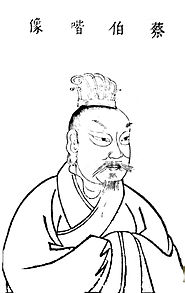Cai Yong
| Cai Yong | |
|---|---|

Portrait of Cai Yong in Sancai Tuhui
|
|
| Scholar of Eastern Han Dynasty | |
| Born | 132 |
| Died | 192 (aged 59–60) |
| Names | |
| Traditional Chinese | 蔡邕 |
| Simplified Chinese | 蔡邕 |
| Pinyin | Cài Yōng |
| Wade–Giles | Ts'ai Yung |
| Courtesy name | Bojie (伯喈) |
| Cai Yong | |||||||||||||||||||
| Chinese | 蔡邕 | ||||||||||||||||||
|---|---|---|---|---|---|---|---|---|---|---|---|---|---|---|---|---|---|---|---|
|
|||||||||||||||||||
| Transcriptions | |
|---|---|
| Standard Mandarin | |
| Gwoyeu Romatzyh | Tsay Iong |
| IPA | [tsʰâi̯ i̯ʊ́ŋ] |
| Yue: Cantonese | |
| Yale Romanization | Choi Yūng |
| Jyutping | Coi3 Jung1 |
| Southern Min | |
| Tâi-lô | Tshuà Iong |
Cai Yong (132–192 CE) courtesy name Bojie was a scholar of the Eastern Han Dynasty. He was well-versed in calligraphy, music, mathematics and astronomy. One of his daughters was the famous Cai Wenji.
Cai Yong was born into a substantial local family in Chenliu (陳留, modern Qi County, Kaifeng, Henan), which had a reputation of not having their territory divided for three generations. When his father Cai Leng died, Cai Yong lived with his uncle Cai Zhi while taking great care for his own mother for her last three years. When she died, Cai Yong became known for his arrangement of his mother's tomb. After that, Cai Yong studied composition, mathematics, astronomy, pitch-pipes, and music under Hu Guang (胡廣), one of the highest-ranking officials in the Han court.
In the early 160s Cai Yong was recommended to the Emperor Huan by the senior eunuchs for his skill with the drums and the guqin. On his way to the capital, Cai Yong feigned illness to return home to study in seclusion. Ten years later in the early 170s, Cai Yong went to serve Qiao Xuan as a clerk, and Qiao Xuan greatly admired his abilities. Afterwards, Cai Yong served as a county magistrate and then a Consultant in the capital, in charge of editing and collating the text in the library. Known for his literary skills, he was constantly commissioned to write eulogies, memorial inscriptions, and the like.
In 175, in fear of parties trying to alter the Confucian classics to support their views, Cai Yong and a group of scholars petitioned to have the Five Classics engraved in stone. Emperor Ling approved, and the result was the Xiping Stone Classics (熹平石經), completed in 183, which set the canon for future generations of scholars.
...
Wikipedia
